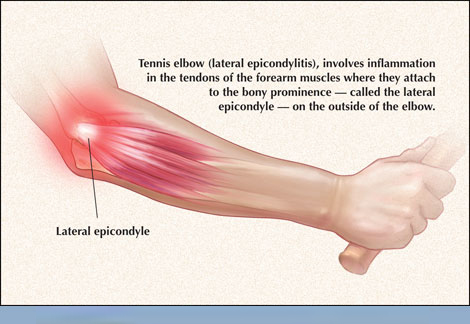Injuries: How to treat Tennis Elbow

Thankfully this isn’t something I’ve suffered from, mainly because I learnt early on how to fix it. However in searching for help with my tennis injuries I keep coming across this advice. It’s interesting to me because it considers one of the many contentious issues I’ve found in injury recovery theory. Ice is it helpful.
It’s useful to compare these ideas with the tendon expert. He absolutely loves ice therapy. He is the first to give me a decent explanation for its use. One which makes sense but at the same time I can’t say it’s convinced me. The the relatively small improvement ice makes compared to the hassle of using it is why I don’t bother because I have so much else to do. No studies prove conclusively that ice helps or hinders recovery but I expect only 5-10% improvement in recovery time. This is great for professionals on deadlines but not for fathers with lives.
The overall concept the tendon expert espouses is still the same though. Removing the pain causing dynamic is the best solution. It worked for my wrist. I am confident it will work for my toe and the same for my ankle. So while tennis elbow is one of the most common injuries I feel the lessons apply to all inuries.
- Improve technique.
- Appreciate the improvements that come from sufficient rest.
- Understand how to win without the big guns eg. plan B. Learn from Fed and Rafa. Rafa may outplay fed but it’s unsustainable.
- Fed plays for the season. Nadal just plays for the match. He has no long term plan and long term injury worries.
The tennis elbow tutor considers whether braces help or support tendon healing and is convinced that braces slow your healing and recovery. Yet every match I watch at least one of the competitors is using a brace. The concept of braces is good but they didn’t help for my wrist injury because they weren’t designed for it. So I m not convinced they help with healing. I expect they simply protect athletes that are committed to playing and so they cannot rest and must protect instead. The races probably come off when competition is over and the athletes takes days out to recover.
I am considering using them for my ankle while playing to help restrict movement. Not for general use but as protection.
Rest
Again, rest is useful in the short term and in acute injuries but not long term. It weakens the whole and doesn’t encourage the correct kind of healing. The fibres don’t align properly.
Should your rest your tennis elbow?
There also isn’t enough support on mental preparation for recovery. Seeing it as its own tournament. The adjustments you must make.



